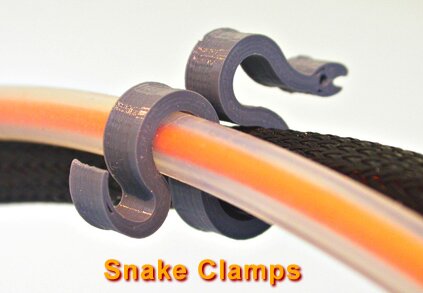Introduction
This page contains 3D-models and manuals on 3D-printing. I developed these methods and models for use in our own laboratory, for our Ultimaker2 printers, so they work well for us. I hope they will be useful for other people too. Before you use any of them, you need to evaluate the safety and usefullness for your environment, which may differ from mine, and use common sense. The risk is all yours. I can not be held responsible for any problems these methods or models would cause on your systems. All files should be virus-free, as we have a central antivirus running continuously on these servers. However, I recommend you verify every file after downloading, just to be sure. Redistribution is allowed, as long as you follow the license terms (see at the bottom of this page).
The Salt Method: wiping the glass bed of a 3D-printer with *salt water* improves bonding of PLA
This manual describes a new way to get a good bonding of PLA to a heated glass bed of a 3D-printer, by treating that build-plate with salt water. Hence the name "the salt method". When the glass is hot, the bond is strong. But after cooling down, adhesion is zero and the models pop off by themself. This works excellently with PLA, but does not work well with ABS. Other materials give mixed results. This manual is published under a CC BY-SA license.
File: bonding_pla_with_salt_water_v20160713.pdf (PDF - 2.2 MB)
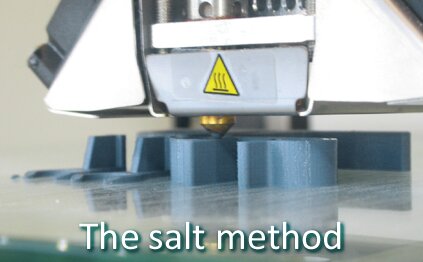
Improved and more gentle "atomic method" to clean 3D-printer nozzles
The "atomic method" is a well known technique to clean the inside of the nozzle of a 3D-printer. Although it works great to remove dirt, it has a few risks due to its brutal pulling.
This improved atomic method works equally well, but it is a lot more gentle, without any risk of causing damage to the printer. Basically, it replaces the brutal pulling by gently turning and wiggling, and deeper cooling. The manual is published under a CC BY-SA license.
File: improved_atomic_method_v20160713.pdf (PDF - 2.7MB)
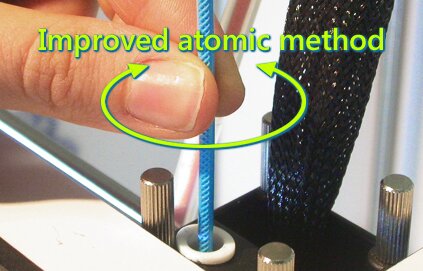
Compact Low-friction UM2 Spool Holder
This is a very compact low-friction spool holder for the Ultimaker2 3D-printer. It fits one standard spool of 750gr (Ultimaker, colorFabb, etc.), and features a standard 608 skater wheel bearing. It is useful when there is limited space available behind the printer, or if you prefer frictionless movement.
The ZIP-file contains the STL-files to print, a JPG-image of each part, the original design files (in RSDOC-format - DesignSpark Mechanical v1.0), and a text-file with more info and instructions. This design is published under a CC BY-SA license.
File: spoolholder.zip (ZIP-file, ca. 4MB)
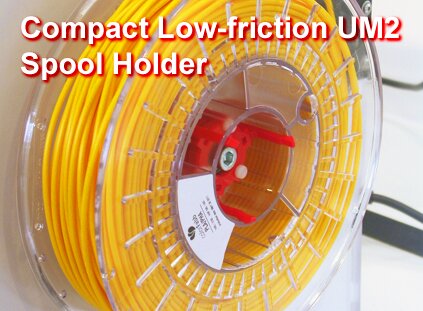
Anti-unwind filament clamp
This clamp prevents the filament from undesired unwinding and from falling off the spools. If used while printing, no locking screws should be used, so the clamp can freely slide over the edge of the spool. The clamp then prevents the filament from falling off the spool sideways, which could cause it to get tangled up. This clamp also makes it much easier to manually unwind a bit of filament, and straighten it, to prevent underextrusion on UM2 printers. Lastly, this clamp can be used to fix the filament while in storage, so it does not unwind, fall off, or get stuck under itself.
The sliding action around the edge of the spool only works for some types of spools. But some spools do have diagonal spokes that prevent the clamp from sliding. The clamping-function while in storage mode however, works for most spools. Note that a lot of newer printers have built-in anti-unwind features and do not need this.
Test the sliding function carefully before use, to make sure it does not get locked-up at some points around the edge!
The zip-file contains the original RSDOC-designs, STL-files to print, several JPG-images, and a text-file with more info. The design is published under a CC BY-SA license, so you are free to customise the design for your own spools.
File: anti_unwind_clamp.zip (ZIP-file - 2.6MB)
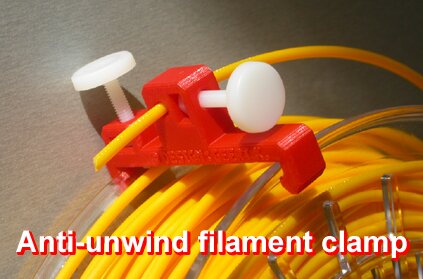
Character set for 3D-printing
This character set is designed to create small text labels in a 3D-print, for 3D-printers with a standard nozzle of 0.4mm. Character height is 3.5mm (caps height), character width is usually 2.0mm, and line-width is 0.5mm. It are flat models, so by extruding you can give them any desired thickness. When using transparent or translucent filaments, it is possible to create watermarks in the model, as shown in this picture.
I also provided testplates to print, to evaluate how any 3D-text would look on your printer and your materials. The test plates contain raised text, recessed text, positive watermarks (=solid text surrounded by voids inside model), negative watermarks (characters are voids inside model), and this in various heights (thickness, or deepness of each character).
The zip-file contains the character sets in RSDOC-fileformat, testplates in STL-fileformat for tryouts, and JPG-images showing what each design and testplate looks like. Be sure to read the txt-file for more info and instructions. This design is published under a CC BY-SA license.
File: characterset.zip (ZIP-file, 4.3MB)
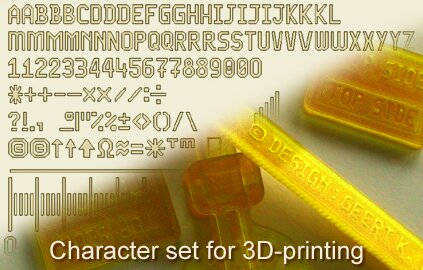
Recently Jason Chall put some characters of this set into a font-files, so these fonts should now work in other editors too. Thanks. See here on Github or Thingiverse for the font-files (TTF, EOT, SVG). (Links open in new windows):
- https://github.com/pbz/geert-font
- https://www.thingiverse.com/thing:4160261/files
Improved horseshoe clips for bowden tube
The standard horseshoe clip to lock the bowden tube, is perfect for systems that do not require frequent disassembling. But if you want to do regular nozzle cleaning (="atomic pulls"), this new clip gives a far better grip: you can easily take it off and slide it on again. Its base dimensions are the same as the original clips. Print slow, as cool as possible, in thin layers, and multiple copies at the same time for best quality. A slightly flexible material is preferred, such as PET.
This ZIP-file contains the STL-file to print, a JPG-image, and the original design file (RSDOC-format - DesignSpark Mechanical v1.0). This model is published under a CC BY-SA license.
File: tube_coupling_clip2.zip (ZIP-file - 109 kB)
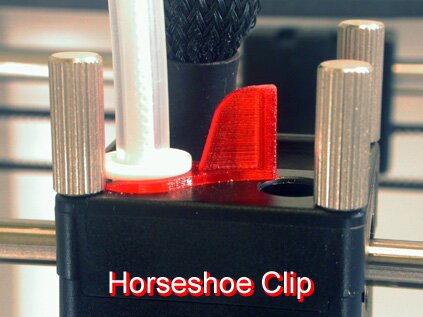
Improved bowden tube clamps - "Snake clamps"
These clamps for the bowden tube - "snake clamps" - have a very loose fit, so they do not risk choking the bowden tube, and do not cause extra filament friction. Print them in a somewhat flexible material, not in PLA: this gets too hard and brittle after a year or so.
The ZIP-file contains the STL-file to print, plus several JPG-images and the original design files (RSDOC-format - DesignSpark Mechanical v1.0). Published under a CC BY-SA license.
File: snake_clamps.zip (ZIP-file - 1.5Mb)
